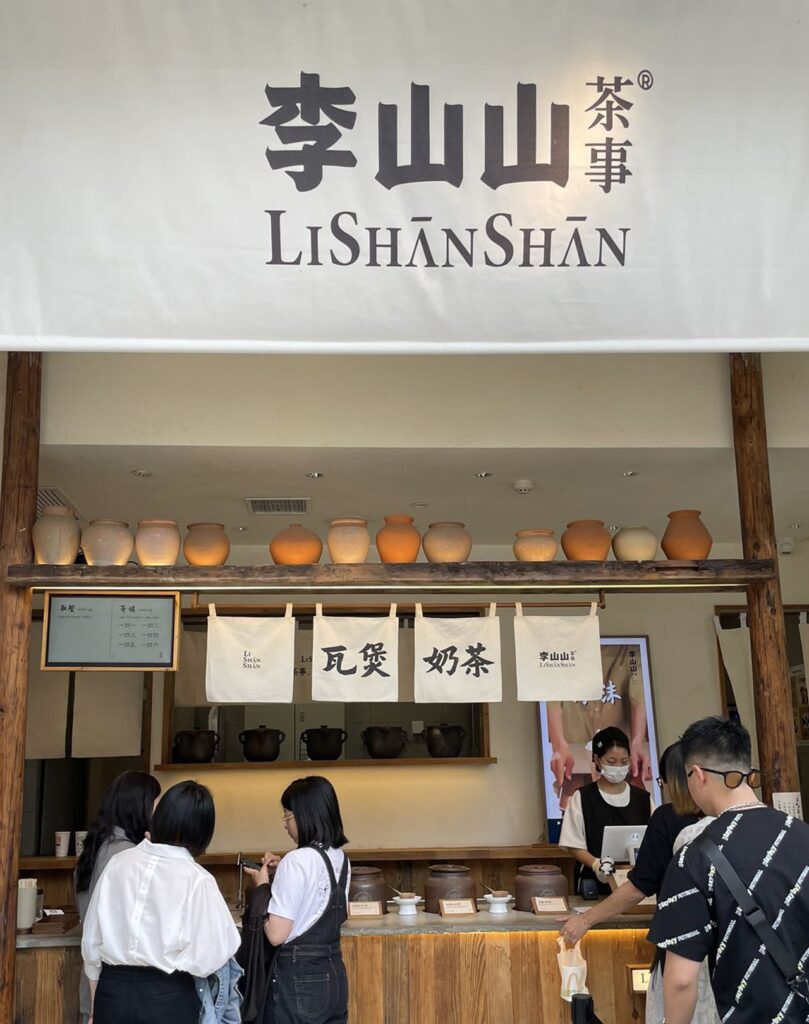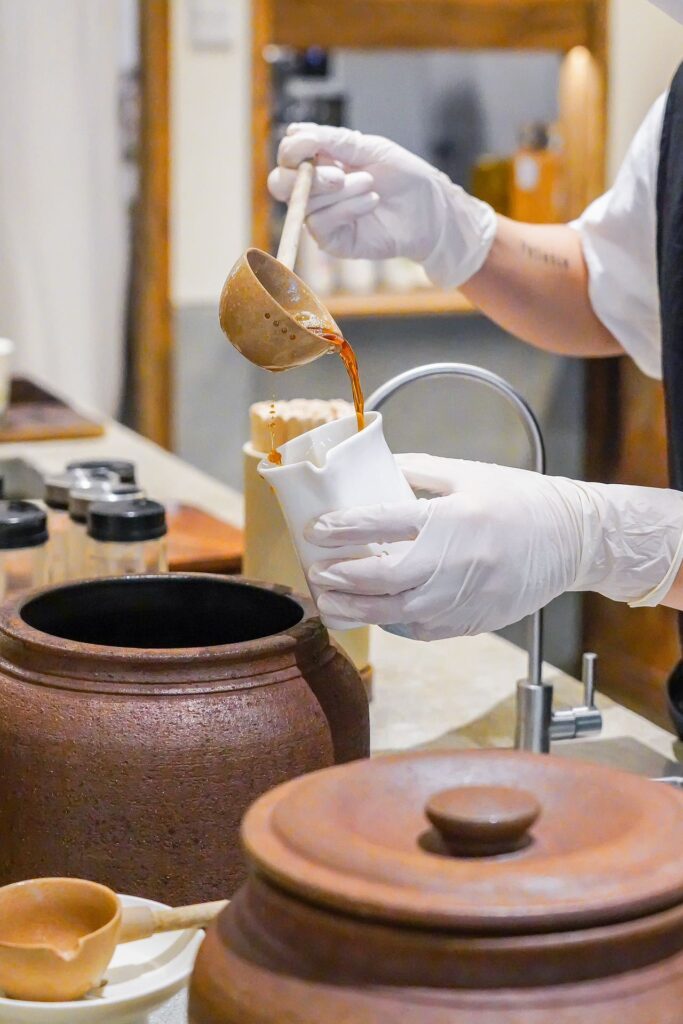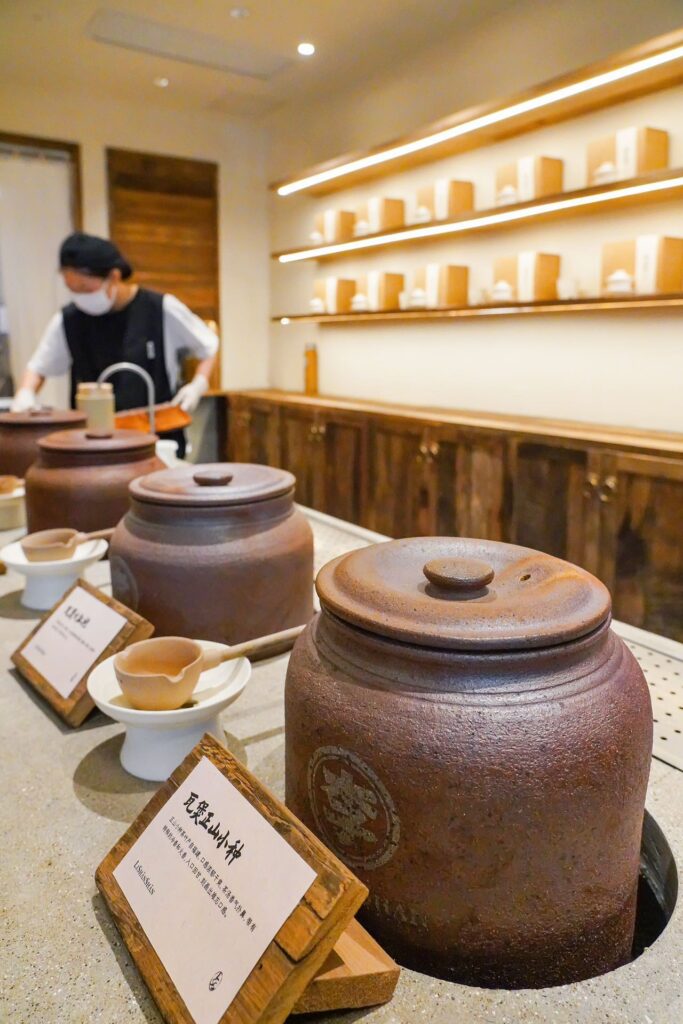At the heart of Chengdu’s bustling Chunxi Road, a new tea brand, Li Shanshan Tea, has quietly emerged—and it’s turning heads.
During its trial phase, Li Shanshan Tea avoided the usual fanfare of discounts and delivery options. Instead, the team focused on foot traffic, offering just one promotion: a modest 20% markdown during the trial period. The rationale was simple: the brand didn’t feel ready to charge the full price—the store decor, team coordination, and product consistency still weren’t up to the brand’s own standards.
Another thing that sets Li Shanshan Tea apart is its no-takeout policy, and the brand recommends drinking each cup within five minutes to taste the optimal flavor. Clearly, the aim is for customers to enjoy tea at its freshest.

In an industry where omnichannel strategies and price wars are the norm, can a brand like this survive? The answer, surprisingly, is yes. Over the past six months, Li Shanshan Tea has made its mark on Chunxi Road, earning a spot on Meituan’s list of top-rated beverage shops. It has also opened six stores in the area, with a seventh on the way.
The milk tea market has long been saturated, with many brands struggling this year due to price competition and product uniformity. But that hasn’t stopped new players like Li Shanshan Tea from entering the fray. 36Kr spoke with Li Shen, the brand’s founder, about its innovative approach to fresh milk tea and the vision for a modern Chinese teahouse chain.
A blend of tradition: Claypot milk tea in a modern teahouse
Li Shanshan Tea fuses traditional Chinese elements with a modern flair. The store’s modest interiors—featuring bamboo curtains, claypots, white walls, and wooden furnishings—are designed to evoke a sense of old-world charm. According to Li, the look was inspired by classic Chinese teahouses. “While others chase modern Chinese aesthetics, we’re more focused on tradition,” he said.
The product menu is intentionally simple, offering two main categories: pure tea and fresh milk tea, with each drink centered around a brewed tea base. The former features cold-brewed tea leaves mixed with young coconut water and varieties like grapefruit-scented Qilan tea, silver tea, lychee black tea, and Shanlinxi tea. Meanwhile, the latter blends original teas with animal light cream and pure cow’s milk. A “foam” series is also available, which adds an extra layer of flavor and toppings to the menu items.
But the real standout is its claypot milk tea, brewed using traditional claypots. Staff scoop tea from claypots, contrasting with the stainless-steel brewers found in most modern tea shops. Though the claypots might look old-fashioned, Li Shanshan’s use of them is anything but a gimmick.

The art of brewing tea has a long history, evolving from boiling to steaming, steeping, and extracting. Brewing tea in claypots is one of the oldest methods. In The Classic of Tea, tea master Lu Yu described ancient tea brewed in claypots, though he considered it outdated. Yet, claypot teamaking has endured, especially in rural areas of southwest and northwest China. The method even influenced Hong Kong’s famous claypot milk tea, which has a richer flavor thanks to the slower brewing process.
Li Shanshan Tea uses claypots made from Sichuan’s Yixing ceramics, a traditional craft with over two millennia of history. These claypots, now recognized as a piece of China’s cultural heritage, combine practicality with artistry and are commonly found in everyday Chinese homes.
During staff training, Li Shanshan Tea demonstrates the difference between tea brewed in claypots versus other vessels. According to Li, once employees and franchisees taste the difference, consensus is easily reached: claypot-brewed tea has a richer aroma and flavor.
Drawing on Chengdu’s rich tea culture, Li Shanshan Tea taps into a heritage that dates back over 3,000 years. The region, known as Ba Shu, is considered the birthplace of China’s cultivated tea. Tea has long been a part of life in Chengdu.
“Chengdu has a deep tea house culture,” Li told 36Kr. Tea is everywhere, but it’s casual—people brew loose leaf tea at home or in mahjong parlors. “It’s not fancy, but there’s a strong demand for tea in everyday life.”
Li Shanshan Tea also invests heavily in high-quality ingredients. The store offers over ten types of tea bases, many of which are top-of-the-line, with costs reaching RMB 400–500 (USD 56.2–70.3) per kilogram. By comparison, other brands typically use tea that costs a fraction of that price.
The brand’s rustic claypot milk tea reflects Li Shanshan Tea’s dedication to preserving traditional techniques. “It’s hard to build a competitive edge with just good tea leaves,” Li explained. Ultimately, the aim is to create a unique product by blending the old and the new.
Beyond Chengdu: Li Shanshan Tea’s expansion plans
Li Shanshan Tea started in the heart of Chengdu’s Chunxi Road, a district known for balancing tradition and modernity. The combination of claypot tea and contemporary milk tea feels right at home here.
Interestingly, Li Shanshan Tea didn’t secure the busiest locations. Instead, it opted for a quieter corner. As a young brand, Li explained that the brand did not want to rely on a prime location to attract customers, but for the product to speak for itself. However, staying in a high-traffic district ensures that customers can easily stop by while shopping.
After establishing its first store, Li Shanshan Tea quickly expanded, opening seven locations in the Chunxi Road area alone. Surprisingly, this hasn’t hurt business. In fact, it has had an exponential effect, where all the stores benefit. On social media, customers now refer to Li Shanshan Tea as a must-try brand on Chunxi Road.
One reason for the brand’s rapid growth is the rising trend of Chinese-style milk tea. According to Li, the industry is moving from modern milk tea brands like Heytea toward more traditional Chinese-style beverages. “The more a brand connects with Chinese tea culture, the better it can grow,” he noted.

The shift toward Chinese-style tea drinks is significant. Brands like SexyTea and Chagee are leading the charge, while regional brands like Tea’stone in Shenzhen, Chahuanong in Xi’an, Quchashan in Guiyang, and Chichas in Chengdu are also emerging. Herbal teas, inspired by traditional Chinese medicine, are becoming popular as well.
The shift toward health-conscious choices is fueling the rise of Chinese-style milk tea. More and more consumers are gravitating toward fresher ingredients, trimming down on sugar, and seeking out zero trans-fat options. Big-name tea brands are catching on, rolling out drinks brewed with original tea leaves and adding calorie and caffeine labels to cater to this growing demand.
Li Shanshan Tea’s approach has broadened its customer base, attracting not only younger crowds but also those over the age of 50. Li said older customers don’t feel out of place in its stores. “We don’t want to be a brand that only young people would visit,” he said. Younger customers, meanwhile, appreciate the traditional elements without feeling alienated.
Despite its success, Li Shanshan Tea is careful not to become just another passing fad. “Brands that last are validated by the market and accepted by consumers for its product,” Li said. “If you rely on trends, you’ll eventually fade.”
This year, Li Shanshan Tea has aggressively expanded beyond Chengdu. Since the second quarter, the brand has opened stores in Guiyang, Xi’an, Nanjing, Chongqing, and other cities, bringing its total to 29 locations. The current focus is on western and central China, with plans to expand eastward. Each new city gets a local office to ensure smooth operations.
Li Shanshan Tea’s store models vary depending on location. In residential areas, stores are larger with outdoor seating, while shops in commercial districts are designed for quick takeout. The typical store size is about 40–60 square meters, with drinks priced between RMB 15–20 (USD 2.1–2.8).
But expansion is just one part of its strategy. “Right now, our focus is on two things: product and service consistency, and staff training,” Li said. “Building a strong team doesn’t happen overnight.”
KrASIA Connection features translated and adapted content that was originally published by 36Kr. This article was written by Yang Yafei for 36Kr.
